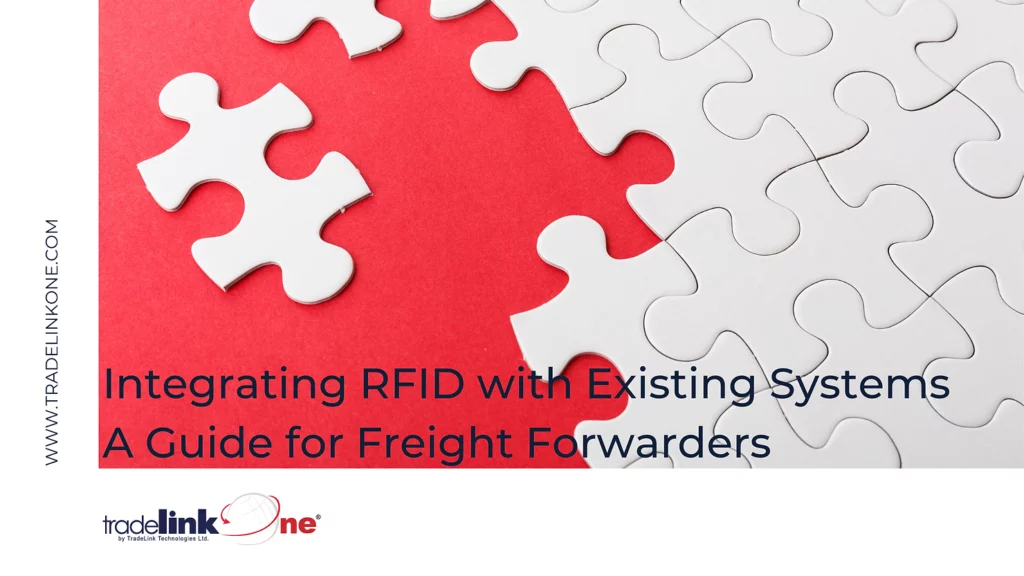
In the fast-paced world of logistics, efficiency and accuracy are of the utmost importance. As freight forwarders strive to optimize their operations, technologies such as Radio Frequency Identification (RFID) offer significant advantages. However, the challenge lies in seamlessly integrating RFID solutions into existing logistics systems. This article explores the essential aspects of this integration, including data integration, technological advancements, and the collaboration of all parties involved, while highlighting the strengths of TradeLink Technologies in this domain.
Benefits of RFID in logistics
1. Real-time tracking: RFID allows for real-time tracking of shipments, enabling freight forwarders to provide accurate updates to clients.
2. Increased efficiency: Automation reduces manual handling, minimizing errors and speeding up processing times.
3. Enhanced inventory management: RFID provides precise data on inventory levels, enabling better forecasting and stock management.
4. Improved security: RFID tags can help prevent theft and loss by providing a reliable tracking mechanism.
Steps for seamless integration
Integrating RFID with existing systems requires a systematic approach. Here’s a step-by-step guide for freight forwarders looking to adopt this technology.
1. Assess current systems
Before integrating RFID, it’s essential to conduct a comprehensive assessment of existing logistics systems. This includes inventory management, shipping, and tracking systems. Understanding the current landscape will help identify gaps that RFID can fill and how it can enhance existing processes.
2. Define integration objectives
Clearly outline the objectives for integrating RFID technology. Whether it’s to improve inventory accuracy, enhance real-time tracking, or streamline documentation processes, having defined goals will guide the integration process and ensure alignment among stakeholders.
3. Choose the right RFID solution
Selecting the appropriate RFID system is crucial. Consider factors such as tag type (passive vs. active), reader range, and compatibility with existing software. Collaborating with technology providers like TradeLink Technologies can provide insights into the best solutions tailored to your specific needs.
4. Develop a data integration plan
Data integration is a critical component of RFID implementation. This involves connecting RFID data to existing software systems, such as Warehouse Management Systems (WMS) and Transportation Management Systems (TMS). Here are key considerations for data integration:
- Data compatibility: Ensure that the RFID system can communicate seamlessly with current databases. APIs (Application Programming Interfaces) can facilitate this connection, allowing for real-time data exchange.
- Data standardization: Standardize data formats to avoid discrepancies and ensure consistent information across platforms.
- Data governance: Establish protocols for data management to maintain data accuracy, security, and compliance.
5. Pilot testing
Conduct pilot tests to evaluate the effectiveness of the RFID system in a controlled environment. This phase allows freight forwarders to identify potential issues, refine processes, and train staff before a full-scale rollout. Monitoring key performance indicators (KPIs) during this phase will provide valuable insights into the system’s performance.
6. Training and change management
Successful integration requires comprehensive training for employees who will be using the RFID system. This includes understanding how to operate RFID equipment, interpret data, and adapt to new workflows. Change management strategies are essential to address any resistance and ensure that all parties are on board with the new technology.
7. Full-scale implementation
Once the pilot test is successful and staff is adequately trained, proceed with full-scale implementation. Monitor the system closely during the initial rollout, making adjustments as necessary. Continuous feedback from users will be invaluable in refining processes and maximizing the benefits of RFID technology.
Collaboration among stakeholders
For RFID integration to be successful, collaboration among all parties involved in the supply chain is vital. This includes manufacturers, freight forwarders, customs officials, and end customers. By fostering open communication and sharing data, all stakeholders can benefit from improved visibility and efficiency.
Engaging with technology providers
Working with a reliable technology partner is critical. TradeLink Technologies stands out as a leader in integrating RFID solutions with existing systems. With extensive experience in data integration, TradeLink provides comprehensive solutions that address the unique challenges faced by freight forwarders. Their expertise ensures a smooth transition to RFID technology, allowing companies to leverage the full potential of this innovative solution.
TradeLink Technologies: A leader in RFID integration
TradeLink Technologies has established itself as a pioneer in the logistics industry by providing innovative RFID solutions that seamlessly integrate with existing systems. Their approach focuses on:
- Custom solutions: TradeLink understands that each business has unique requirements. They offer customized RFID solutions tailored to meet specific operational needs.
- Comprehensive support: From initial assessments to full implementation and ongoing support, TradeLink provides end-to-end services that ensure successful integration.
- Expertise in data integration: With a deep understanding of logistics data, TradeLink excels in creating solutions that facilitate smooth data flows between RFID systems and existing software.
- Training and education: TradeLink places a strong emphasis on training and education, empowering staff to maximize the benefits of RFID technology.
Conclusion
Integrating RFID technology into existing logistics systems offers immense potential for freight forwarders. By following a systematic approach, defining clear objectives, and collaborating with experienced partners like TradeLink Technologies, companies can achieve a seamless integration that enhances efficiency, accuracy, and customer satisfaction. As the logistics landscape continues to evolve, embracing RFID will be a crucial step towards staying competitive and meeting the demands of an increasingly dynamic market.
